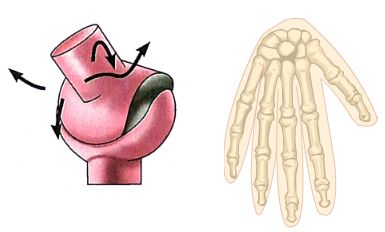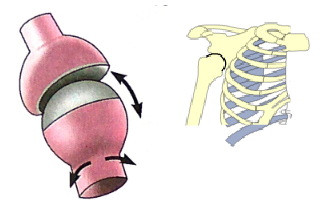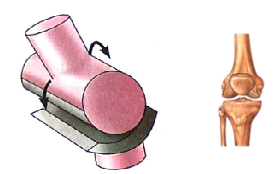Our Skeletal System and the Skin
Based on Maharashtra Board Class 6th General Science Chapter 8
Solution
Question 1:
Fill in the blanks with the proper word.
(a) The place where two or more bones are connected is called a .............. .
(b)Cells of the epidermis contain a pigment called .............. .
(c) ...................... and ...................... are the two layers of the human skin.
(d)The human skeletal system is divided into ...................... parts.
(a) The place where two or more bones are connected is called a joint. (b)Cells of the epidermis contain a pigment called melanin. (c) Epidermis and dermis are the two layers of the human skin. (d)The human skeletal system is divided into two parts.
Question 2:
Match the pairs.
| 'A' | 'B' |
| (1) Ball and socket joint | (a) Knee |
| (2) Hinge joint | (b) Wrist |
| (3) Gliding joint | (c) Shoulder |
'A'
'B'
(1) Ball and socket joint
(c) Shoulder
(2) Hinge joint
(a) Knee
(3) Gliding joint
(b) Wrist
Question 3:
Right or wrong? If wrong, write the correct sentence.
(a) Bones are soft.
(b)The human skeleton protects the internal organs.
(a) Bones are soft- Wrong -Bones are hard and non flexible. (b)The human skeleton protects the internal organs- Right
Question 4:
Put a √ mark at the proper places.
(a) The system which gives a definite shape to our body.
Excretory system
Respiratory system
Skeletal system
Circulatory system
√ Skeletal system
(b) The ................ joint is seen in fingers and toes.
Hinge joint
Ball and socket joint
Immovable joint
Gliding joint
√ Hinge joint
Question 5:
Answer the following questions in your words.
(a)What are the functions of your skin?
The most important functions of the skin are:
(b)What should you do to keep your bones strong and healthy?
For keeping the bones strong and healthy, we need to take proper diet.
(c)What are the functions of the human skeletal system?
The skeletal system includes all of the bones and joints in the body. It performs the following functions:
(d)Which are the various reasons due to which our bones might break?
Bones are structures which are hard and non flexible. The chances of breaking of bones occurs, if the bones are weak. There are various reasons due to which bones may become weak and may break:
(e) What are the different types of bones? How many types are there?
There are 4 types of bones: 1. Long bones: These type of bones are longer than wider and they function to support the weight of the body and facilitate movement 3. Flat bones: They are thin shaped and, in some cases, provide mechanical protection to soft tissues beneath or enclosed by the flat bone.
2. Short bones: They are almost cube shaped bones as they are equal in their length and width.
4. Irregular bones: They have complicated shapes which cannot be classified as 'long', 'short' or 'flat'. Their shapes are due to the functions they fulfill within the body.
Question 6:
What will happen if -?
(a)There are no joints in our body.
Joints are the places where two bones are joined together. They permit the various kinds of movement which we carry out in order to fulfill our requirements. If there are no joints in our body, we will not be able to move. The bones can not show movements without joints
(b)There is no melanin pigment in our skin.
Melanin is a pigment which is found in skin and hair as well. It is important for two reasons, firstly it imparts colour to our skin and the tone of our skin depends on the amount of melanin pigment, secondly it protects our skin and the inner parts from ultraviolet rays.
(c) Instead of 33 vertebrae in our body, we had one single and straight bone.
Question 7:
Draw diagrams.
(a) Types of joints Types of joints 2. Ball and socket joint 3. Hinge joint
1. Gliding joint


(b) Structure of the skin
Structure of skin

Click on below link to download pdf from store:
MSBSHSE-Class-6-Science-Chapter-8-Our Skeletal System and the Skin-Notes
MSBSHSE-Class-6-Science-Chapter-8-Our Skeletal System and the Skin-Solution
MSBSHSE-Class-6-Science-Chapter-8-Our Skeletal System and the Skin-Book
Useful links of Class 6th General Science :
| Main Page : Class 6th MSBSHSE – General Science - All chapters notes, solutions, videos, test, pdf.
Books : Maharashtra Board-Class 6th Science Text Books – Chapter wise PDF for download Videos : MSBSHSE-Class-6-Science-Videos- All Chapter videos Previous Chapter : Chapter-7-Nutrition and Diet - Online Solution Next Chapter : Chapter-9-Motion and Types of Motion - Online Solution |